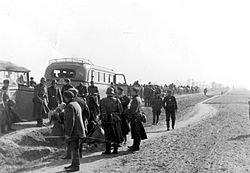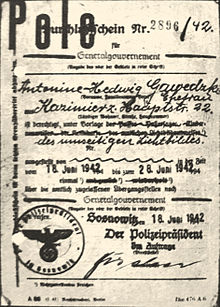Expulsion of Poles by Germany
Nazi German ethnic cleansing of annexed Poland. | |
| Duration | Partitions of Poland,[1] World War II |
|---|---|
| Location | German-controlled territories |
| Type | Ethnic cleansing |
| Cause | Lebensraum, anti-Polish sentiment |
| Patron(s) | Frederick the Great, Otto von Bismarck, Adolf Hitler |
| Outcome | Expulsion of 325,000 Poles.[2] |
The expulsion of Poles by Germany was a prolonged anti-Polish campaign of ethnic cleansing by violent and terror-inspiring means lasting nearly half a century. It began with the concept of Pan-Germanism developed in the early 19th century and culminated in the racial policy of Nazi Germany that asserted the superiority of the Aryan race. The removal of Poles by Germany stemmed from historic ideas of expansionist nationalism. It was implemented at different levels and different stages by successive German governments. It ended with the defeat of Nazi Germany in 1945.[3]
The
Background
Poles had constituted one of the largest minorities in the German Empire since its creation in 1871. This was a result of the earlier acquisitions made by Prussia, the state that initiated the Unification of Germany. The Electorate of Brandenburg (later Kingdom of Prussia), with its capital in Berlin after 1451, acquired historic lands with significant Polish population in a series of military operations,[4] and, in the second half of the 18th century, had seized western territories of the Polish Kingdom by taking part in the Partitions of Poland and the Silesian Wars with Austria.
The idea of
German Empire
In the territories annexed during the Partitions of Poland, German authorities sought to limit the number of ethnic Poles by their forced
In 1908, Germany legalized the eviction of Poles from their properties under pressure from pan-
World War I
In August 1914 the German imperial army
World War II

With the occupation of Poland following the German invasion of the country, Nazi policies were enacted upon its Polish population on an unprecedented scale. According to Nazi ideology Poles, as
World War II expulsions took place within two specific territories: one area annexed to Reich in 1939 and 1941, and another, the General Government, precursor to further expansion of German administrative settlement area. Eventually, as Adolf Hitler explained in March 1941, the General Government would be cleared of Poles, the region would be turned into a "purely German area" within 15–20 years and in place of 15 million Poles, 4–5 million Germans would live there, and the area would become "as German as the Rhineland.[11]
Expulsions from Polish territories annexed by Nazi Germany
The Nazi plan to ethnically cleanse the territories occupied by Germany in Eastern Europe during World War II, was called the
These expulsions were carried out so abruptly that ethnic Germans being resettled there were given homes with half-eaten meals on tables and unmade beds where small children had been sleeping at the time of expulsion.[14] Members of Hitler Youth and the League of German Girls were assigned the task of overseeing such evictions to ensure that the Poles left behind most of their belongings for the use of the settlers.[15] According to Czesław Łuczak, Germans expelled the following numbers of Poles from territories annexed to the Reich in the period of 1939–1944:

| Name of territory | Number of displaced Poles |
|---|---|
| Warthegau region
|
630,000 |
| Silesia | 81,000 |
| Pomerelia | 124,000 |
| Białystok | 28,000 |
| Ciechanów | 25,000 |
| So called "Wild expulsions" of 1939 (Pomerelia mostly) | 30,000 – 40,000 |
| Polish areas annexed by Nazi Germany (total) | 918,000 – 928,000 |
| Zamość region | 100,000 – 110,000 |
| General Government | 171,000 |
| Warsaw uprising )
|
500,000 |
| Grand total, on all occupied Polish territories | 1,689,000 – 1,709,000 |
Combined with "wild expulsions", in four years 923,000 Poles were ethnically cleansed from territories Germany annexed into the Reich.[17]
Expulsions from General Government
Within the territories of the German protectorate called General Government there were two main areas of expulsions committed by the German state. The protectorate itself was seen as temporary measure, and served as a
Zamość
Some 116,000 Poles were expelled from the
Warsaw
In October 1940, 115,000 Poles were expelled from their homes in central Warsaw to make room for the Jewish Ghetto, constructed there by German authorities. (Jews were then expelled from their homes elsewhere and forced to move into the Ghetto.) When the Warsaw Uprising failed, 500,000 people were expelled from the city alone as punishment by German authorities.[17]
Demographic estimates
It is estimated that between 1.6 and 2 million people[18] were expelled from their homes during the German occupation of Poland. The Nazi German organized expulsions—by themselves—affected 1,710,000 Poles directly.[17] New estimates by Polish historians give the number of 2.478 million people expelled.[2] Additionally, 2.5 to 3 million Poles were taken from Poland to Germany as slave labourers to support the Nazi war effort.[10] These numbers do not include people arrested by the Germans and sent to Nazi concentration camps.[18]
In many instances, Poles were given between 15 minutes and 1 hour to collect their personal belongings (usually no more than 15 kilograms per person) before they were removed from their homes and transported east (see: deportations) On top of that about 5 million Poles were sent to German labor and concentration camps.[19] A total of about 6 million Polish citizens were killed during the war, of which approximately half were Jews or of Jewish descent.[20][21] All these actions resulted in significant changes in Polish demographics at the end of the war.[20]
See also
- Drang nach Osten (Drive towards the East)
- Expulsion of Germans after World War II
- Generalplan Ost, Hitler's "new order of ethnographical relations"
- Lebensraum (Living space), the primary political concept used by the Nazis to "justify" the conquest of territory in Poland and Eastern Europe
- Nazi propaganda
- Pacification operations in German-occupied Poland
- Prussian deportations of Poles and Jews in 1885-1890
- Repatriation of Poles (1944–1946)
- World War II evacuation and expulsion
- Chronicles of Terror
Notes and references
- ISBN 0-520-02775-2.
- ^ ISBN 83-01-14179-4.
- Polska Akademia Nauk (Polish Academy of Sciences), Historia Polski, Vol. III 1850/1864-1918, Part 2 1850/1864-1900, edited by Państwowe Wydawnictwo Naukowe, Warsaw1967.
- ^ a b c d e f g h i Imannuel Geiss, Der polnische Grenzstreifen 1914-1918. Ein Beitrag zur deutschen Kriegszielpolitik im Ersten Weltkrieg, Hamburg/Lübeck 1960
- ^ E.J. Feuchtwanger, "Bismarck", Routledge 2002
- ^ Herbert Arthur Strauss, "Hostages of Modernization: Studies on Modern Antisemitism 1870-1933-39 Germany - Great Britain-France", Walter de Gruyter 1993
- ^ Cataclysm: The First World War as Political Tragedy By David Stevenson. Page 108 Accessed 14 March 2011.
- ^ Germany and Eastern Europe edited by Keith Bullivant, Geoffrey Giles, Walter Pape. Page 28 Accessed 14 March 2011.
- ^ Janusz Gumkowski and Kazimierz Leszczynski, "Hitler's War; Hitler's Plans for Eastern Europe", 1961, (in) Poland under Nazi Occupation, Polonia Publishing House, Warsaw, pp. 7-33, 164-178.
- ^ a b Wojciech Roszkowski, Historia Polski 1914–1997, Warsaw 1998
- ISBN 9042006889– via Google Books
- ISBN 0-393-02030-4
- ISBN 1-56584-549-8
- ISBN 0-679-77663-X
- ^ Walter S. Zapotoczny, "Rulers of the World: The Hitler Youth"
- ISBN 832100010X
- ^ a b c d Zygmunt Mańkowski; Tadeusz Pieronek; Andrzej Friszke; Thomas Urban (panel discussion), "Polacy wypędzeni", Biuletyn IPN, nr5 (40) May 2004 / Bulletin of the Institute of National Remembrance (Biuletyn Instytutu Pamięci Narodowej), issue: 05 / 2004, pages: 628, [1] Archived 2015-10-18 at the Wayback Machine
- ^ a b "Poles: Victims of the Nazi Era" Archived November 28, 2005, at the Wayback Machine at US Holocaust Memorial Museum
- ^ Dr Waldemar Grabowski, IPN Centrala (2009-08-31). "Straty ludności cywilnej". Straty ludzkie poniesione przez Polskę w latach 1939-1945. Bibula – pismo niezalezne. Retrieved February 20, 2013.
Według ustaleń Czesława Łuczaka, do wszelkiego rodzaju obozów odosobnienia deportowano ponad 5 mln obywateli polskich (łącznie z Żydami i Cyganami). Z liczby tej zginęło ponad 3 miliony.
- ^ a b Poland's World War II casualties.
- ^ "Holocaust: Five Million Forgotten: Non Jewish Victims of the Shoah," see also: The Forgotten Holocaust, by Richard C. Lukas, University Press of Kentucky; and The Jews and the Poles in World War II by Stefan Korbonski, Hippocrene Books.
Bibliography
- Maria Rutowska, "Wysiedlenia ludności polskiej z Kraju Warty do Generalnego Gubernatorstwa 1939-1941" Instytut Zachodni, Poznań 2003,ISBN 83-87688-42-8
- ISBN 83-210-0010-X
- Czesław Łuczak, "Położenie ludności polskiej w Kraju Warty 1939 - 1945", Wydawnictwo Poznańskie 1987
- Czesław Madajczyk, Generalny Plan Wschodni: Zbiór dokumentów, Główna Komisja Badania Zbrodni Hitlerowskich w Polsce, Warsaw, 1990
- Czesław Madajczyk, Generalna Gubernia w planach hitlerowskich. Studia, PWN, Warsaw. 1961
- Czesław Madajczyk, Polityka III Rzeszy w okupowanej Polsce, Warsaw, 1970
- Andrzej Leszek Szcześniak, Plan Zagłady Słowian. Generalplan Ost, Polskie Wydawnictwo Encyklopedyczne, Radom, 2001
- Piotr Szubarczyk (IPN Gdańsk), "Umacnianie niemczyzny" na polskim Pomorzu, Nasz Dziennik, 03.09.2009
- L. Chrzanowski, "Wypędzenia z Pomorza," Biuletyn Instytutu Pamięci Narodowej”, 2004, nr 5 (40), ss. 34 – 48.
- W. Jastrzębski, Potulice. Hitlerowski obóz przesiedleńczy i pracy, Bydgoszcz 1967.
